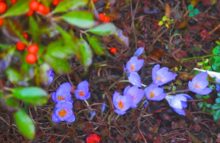Too bad this invention doesn’t exist, as this post about garden plants whose smells I love would be a lot easier. How to describe smells? Almost impossible. I suppose there should be some way of doing it, like the way wine experts use descriptive terms to describe the flavour of wine.
When I read those descriptions I usually find myself saying, “huh?” more often than not, like when the wine expert has used a descriptive word like “leather” or “sawdust” or “asparagus”… I guess I haven’t thoughtfully stuck my nose into that many glasses of wine. I’m definitely unschooled. “Astringent”, I get, but “chewy”?
According to Wikipedia: “A taster’s own personal experiences play a significant role in conceptualizing what they are tasting and attaching a description to that perception. The individual nature of tasting means that descriptors may be perceived differently among various tasters.” And it’s like this with plants: merely substitute “taste” with “smell”. In fact experts say that we are actually smelling most of the things we are tasting.
For me, certain garden smells transport me directly to my grandmother’s garden in North Wales: the sweet and heady scent of carnations (Dianthus), or “pinks” as she called them. Pinks are one of my favourites – one I simply can’t get enough of. Inhaling them transports me into some kind of heaven-y spot in the universe for the brief time I’m breathing in. What does it smell like? You know, carnations!
Lilac (Syringa) takes me to a certain sidewalk in Markham, Ontario, walking to school beside a fence with a very long bank of lilacs. In May, we would snap off a bunch as we walked by, and then continue down the street burying our noses in the blooms. Intoxicating. There’s something so fresh and pure about lilac, yet it’s so dazzlingly heady. What a mix.
The smell of Phlox takes me to memories of walking a woodland path along the Rouge river as a girl: wild phlox (Dame’s Rocket or Hesperis) growing in masses along the river banks, emitting that sweet smell, mixed with the pungency of the wet earth. Heaven. (My sister once bought me a spray perfume called Dirt. She knows me well!)
In June, Helen and I often walk past a particular parkette in our neighbourhood on our way to the library or the bank, where several shrubs of Rosa rugosa bloom under an apple tree.
We always cross the street to inhale from the blooms: we are literally “stop and smell the roses” girls. And yes, we do stick our noses directly into the blooms, after first making sure a bee hasn’t gotten there first. “Aaaaahs” follow. What could be more beatific that the scent of pure rose? And the rugosas have the scent, unlike the modern roses that are found in so many rose gardens.
Real landscape artists buy plant material for the shape, colour, and how its fit into the landscape. This will make your garden look good, which is what most of us are going for. However, more and more often now, I find I search out plant material for smell alone. Even in spite of what it looks like. Even when what they look like works at cross purposes to my current garden scheme, smell is that important to me.
The other day I found myself with a need (compulsion) to purchase some annual summer stocks (Matthiola bicornis) – and I was buying them for the smell alone. I really preferred the single forms of the flowers, but a smell-test confirmed that the blowsier, messier doubles had the best scent, so I got them instead. I potted them up with some sweet alyssum (Lobularia maritima) – another wonderful fragrance: honey.
Imagine yourself bee-size, floating in a boat in a huge jar of honey. Then throw in some ineffable, magical sweetness and you’ve got the summer-wonderful smell of alyssum.
Got these plants home, and then I had some fancy footwork to do to make it all work color-wise with the stuff I already had blooming on my deck. Like the pure orange – bright orange – pansies (Viola) I’ve been enjoying since early April.
The double phlox were pastel pink and lavender – colours I’ve not used in my potscapes … well, ever. I’ve leaned toward hot colours on my deck because my kitchen is a flame orange, and my deck is directly outside my kitchen. I ended up separating the group of orange flowers by a pot of deep purple pansies, and that seemed to allow a reasonable colour transition to the “aromatherapy” pot of alyssum and stocks.
By the way, the orange pansies were new this year too. Usually I go for the blue ones. Why did I get the orange ones this year? The smell is absolutely wonderful!





2 comments
Sarah, you’re so right! The only tiny quibble I might have with what you’ve written is that I think you mean “stocks” not “phlox.” Certain smells always take me back to Gran’s garden: those stocks, wallflowers (reliably biennial in Wales; not here in T.O.), lupins, the roses, of course, and lavender (which you have) come to mind. Or to nose.
Yes, stocks! (That’s the ticket! I mean, that’s what I meant. :^) )And wallflowers. Would love to grow them, but have not succeeded in keeping them overwinter.